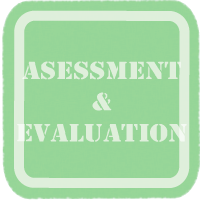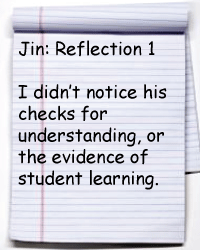 Assessment in the SL/FL Classroom
Assessment in the SL/FL Classroom
|
|
What are the different types of assessment?
- Assessment for learning
- Assessment of learning
- Triangulation
- Student self-assessment & Peer assessment
Assessment for learning (Formative)
Assessment for learning can be described as a formative type of assessment that assesses the process of learning. The term ‘process’ refers to all of the learning that takes place from the Giving It stage of B-SLIM to the Using It stage. Assessment for learning provides proof that a student is trying and working; this assessment is diagnostic and ongoing, focuses on practice and may lead to re-teaching, if necessary. This type of assessment assists the student and the teacher and helps them know what the next steps should be to facilitate continued learning. There is a focus on improvement, comparing a student’s current performance with their previous best and helping them to therefore progress in their learning. When assessing students in this formative way over time, specific and descriptive criteria need to be used in order to actually gauge student progress. 
Assessment of learning (Summative)
In contrast to assessment for learning, assessment of learning refers to summative assessment that evaluates what a student has learned; as such, it focuses on a product or a demonstration of student learning. This type of assessment takes place in the Proving It and Evaluation stages of B-SLIM when students demonstrate their learning through a project, exam, etc. Once a student has been evaluated, their results are compared with those of other students or a set standard. As with assessment for learning, specific criteria need to be in place for assessment of learning to be of use. This assessment provides feedback to the teacher, student, and parents/guardians.
back to top
When and how often should I assess student progress?
When should assessment occur?
Assessment should take place throughout the entire B-SLIM process. It will look different at different times (i.e. assessment of learning should only come at the end of a unit/section, assessment for learning is more ongoing) but it is essential that students’ work and progress constantly be assessed. It is in this way that the teacher can determine which concepts need more attention, which methods of teaching and learning are being utilized most effectively, and where more attention is needed.
How can student progress best be tracked?
To organize and track student progress over extended periods of time, each student should have their own portfolio. It is here where the teacher can keep student work and their own notes about a student’s progress. The portfolio is also where peer and self assessment can be kept. The goal with the portfolio is that the student, as well as the teacher, has access to it and can therefore track their own progress. By reviewing the portfolio’s content, students can personally assess their strengths and areas of improvement, and may gain new insight into strategies they used successfully and be able to use them again. Ideally, a student’s portfolio would travel with them through their academic career, so the student and all future teachers have continuous access to the student’s work.
How can a teacher effectively and accurately assess students?
 |
Watch these videos to hear some assessment techniques from language teachers. (time 4:48) |
time (4:48) |
time (7:14) |
Whether conducting assessment for learning or assessment of learning, a teacher must have sufficient proof of a students’ learning. By using a process known as triangulation teachers can obtain data of student learning from three different sources (products, observations and conversations), thereby collecting sufficient data in order to evaluate student learning.
back to top

Alberta Assessment Consortium.
http://www.aac.ab.ca/
“Curriculum-Based Criterion-Referenced Continuous Assessment: A Framework for the Concepts and Procedures of Using Continuous Assessment for Formative and Summative Evaluation of Student Learning”
http://www.eric.ed.gov/ERICDocs/data/ericdocs2sql/content_storage_01/0000019b/80/13/78/e0.pdf


 Many of our teacher friends mention both the importance and the challenges of assessing in the second language classroom. In this section we will look at formative assessment, an assessment of the learning process, and summative assessment, an assessment of what the student has learned. If we look at the example of Jin we see that he does not notice his mentor teacher's checks for understanding, a form of formative assessment. Unlike tests and projects which usually provide information about what has been 'learned', checks for understanding are a part of assessment that focuses more on the process of 'learning'. Both aspects of assessment- formative and summative- are important parts of the learning process. In addition to formative and summative assessment, in this section we will discuss how assessment applies to the language classroom and look at some strategies for incorporating effective assessment practices into a language program.
Many of our teacher friends mention both the importance and the challenges of assessing in the second language classroom. In this section we will look at formative assessment, an assessment of the learning process, and summative assessment, an assessment of what the student has learned. If we look at the example of Jin we see that he does not notice his mentor teacher's checks for understanding, a form of formative assessment. Unlike tests and projects which usually provide information about what has been 'learned', checks for understanding are a part of assessment that focuses more on the process of 'learning'. Both aspects of assessment- formative and summative- are important parts of the learning process. In addition to formative and summative assessment, in this section we will discuss how assessment applies to the language classroom and look at some strategies for incorporating effective assessment practices into a language program. 

